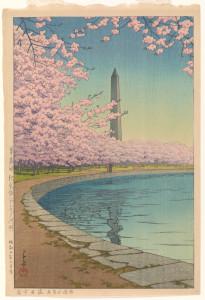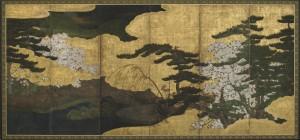 Slowly but surely, spring is creeping up on Washington, D.C., which means that it is time to set the date for a highly anticipated spring event: the National Cherry Blossom Festival. In conjunction with the festival, the Arthur M. Sackler Gallery and the Freer Gallery of Art — the two Asian art museums of the Smithsonian Institution — will be hosting a number of events to enhance visitors’ experiences of the cherry blossoms. Among these is an exhibition at the Freer Gallery called “Seasonal Landscapes in Japanese Screens,” which offers visitors the opportunity to appreciate folding screen paintings illustrating the natural beauty of Japan’s four seasons.
Slowly but surely, spring is creeping up on Washington, D.C., which means that it is time to set the date for a highly anticipated spring event: the National Cherry Blossom Festival. In conjunction with the festival, the Arthur M. Sackler Gallery and the Freer Gallery of Art — the two Asian art museums of the Smithsonian Institution — will be hosting a number of events to enhance visitors’ experiences of the cherry blossoms. Among these is an exhibition at the Freer Gallery called “Seasonal Landscapes in Japanese Screens,” which offers visitors the opportunity to appreciate folding screen paintings illustrating the natural beauty of Japan’s four seasons.
What sets this particular exhibition apart is the medium upon which the paintings are created: the folding screens. As one of the most distinctive forms of Japanese art, the folding screens combine practicality with aesthetic value — the original function of the screens (known in Japanese as byobu, or ‘wind wall’) was to be the interior partitions within traditional Japanese architecture. Spanning several large and continuous panels, the screens are ideally suited to portray the gentle, rolling landscapes of Japanese scenery. From the unfurling cherry blossoms hinting at spring to the colourfully plumaged pheasants taking flight, one’s initial impression of the paintings is that of tranquillity and harmony.
Viewing the screens, it is interesting to consider the genealogy of these folding screen paintings. It is worth noting that several of the painting techniques, hailing from the sixteenth and seventeenth centuries, originate from Chinese art. The bird-and-flower genre, named after its subject matter, comes from Chinese art, but it is re-interpreted and combined with Japanese art’s own techniques and aesthetic sensibilities.
“While certain techniques like the brush strokes of the rocks or experiments with portraying movement into the distance come from Chinese art, the works are distinctly Japanese,” said Ann Yonemura, senior associate curator of Japanese art at both galleries. “If you look at the cherry blossoms, you can see that the flowers look three-dimensional. The relief effect comes from using a pigment made from white shells built up on the surface. Thus, the Japanese were already experimenting with techniques not found in Chinese art.”
 In fact, one may be surprised to find that the paintings contain dynamism and movement despite giving the initial impression of tranquillity and zen. From a distance, each painting appears to simply depict a scene from nature, but upon closer examination, one can spot the amount of breath-taking detail that goes into each piece. For instance, “Landscape with Blossoming Cherry Trees” captures the transient moment when the cherry blossoms are in full bloom; the luxuriant mass of blossoms juxtaposed against the green of the pines makes for a striking contrast, and the little details here and there, from the delicate reeds to the moon shrouded by clouds, all serve to enrich the viewing experience.
In fact, one may be surprised to find that the paintings contain dynamism and movement despite giving the initial impression of tranquillity and zen. From a distance, each painting appears to simply depict a scene from nature, but upon closer examination, one can spot the amount of breath-taking detail that goes into each piece. For instance, “Landscape with Blossoming Cherry Trees” captures the transient moment when the cherry blossoms are in full bloom; the luxuriant mass of blossoms juxtaposed against the green of the pines makes for a striking contrast, and the little details here and there, from the delicate reeds to the moon shrouded by clouds, all serve to enrich the viewing experience.
Of the four folding screens on display, “Flowers and Birds in Spring and Autumn Landscapes” is the most striking, not only in its use of color, but also in its seamless depiction of spring and autumn across the screens. Given that the seasons are a significant theme in Japanese art, this painting exemplifies the practice of composing the folding screens into pairs that juxtapose two seasons. The overall sense of harmony is created by the clever symmetry of the folding screen, where two trees frame each end of the painting.
The landscape is not static; it changes with the transition from the brilliant foliage of fall on the left to the delicate beauty of the budding willows on the right. One cannot help but think about the ever-constant cycle of the seasons and how the rhythms of life — from birth to death to rebirth — are repeated year after year.
Besides the flora and fauna of the Japanese landscape, birds — especially pheasants — form the other half of the bird-and-flower genre. This is especially evident in “Pheasants and Cherry Trees in a Spring Landscape,” a painting that depicts pheasants meeting in the foreground against a pale gold backdrop as another pair take flight. Revered for their beauty, pheasants are an important part of Japanese culture and are regarded as the national bird. Apropos to their lofty position in Japanese culture, the pheasants in the painting are painted with painstaking detail and complement their natural surroundings perfectl y.
y.
Overall, the exhibit is emblematic of characteristics associated with Japanese art — reserved, evocative and of an astoundingly delicate beauty. Although it takes very little time to make a circuit around the four screens on display, one should pause, slow down and enjoy viewing the art away from the humdrum of life outside the museum’s walls.
The Freer Gallery is slated to close for around a year and a half, starting in January 2016, for renovations. Considering the rarity of several of the artefacts on display and the limits on the amount of time exhibits can be out of storage (six months out of every five years, according to Yonemura), it would be smart to make the trip to view one of the finest collections of Asian art in the nation before it closes. In fact, why not consider adding it to your cherry blossom viewing itinerary come cherry blossom season?
“Seasonal Landscapes in Japanese Screens” is the second-to-last exhibition to be featured at the Freer Gallery before its closure, and it will be available for viewing from March 7 until Sept. 6.



















